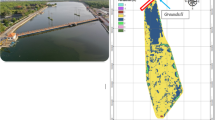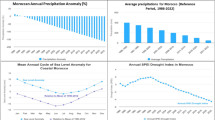Abstract
We used a GIS-based approach to examine the influence of road density and physical watershed features (watershed size, wetland cover, and bedrock type) on water quality in coastal marshes of Georgian Bay, Ontario. We created a GIS that included landscape information and water-quality data from a 9-year synoptic survey of 105 coastal marshes covering 28 quaternary watersheds. Multiple regressions and partial correlations were used to discern confounding effects of human-induced (road density) versus natural physical watershed determinants of water quality. Road density was the dominant factor influencing many water quality variables, showing positive correlations with specific conductivity (COND), total suspended solids (TSS), and inorganic suspended solids (ISS) and a negative correlation with overall Water Quality Index scores. Road density also showed positive correlations with total nitrate nitrogen (TNN) and total phosphorus (TP). By comparison, larger watershed area was the main factor leading to elevated TP concentrations. The proportion of the watershed occupied by wetlands explained the largest amount of variation in TNN concentrations (negative correlation) and was also negatively correlated with COND and positively correlated with TSS and ISS when we controlled for road density. Bedrock type did not have a significant effect in any of the models. Our findings suggest that road density is currently the overriding factor governing water quality of coastal marshes in Georgian Bay during the summer low-flow period. We recommend that natural variation in physical watershed characteristics be considered when developing water quality standards and management practices for freshwater coastal areas.




Similar content being viewed by others
References
Canadian Council of Ministers of the Environment (CCME) (2001) Canadian water quality guidelines for protection of aquatic life: CCME Water Quality Index 1.0. In: Canadian Environmental Quality Guidelines. Canadian Council of Ministers and the Environment, Winnipeg, MB
Chow-Fraser P (2006) Development of the Wetland Water Quality Index to assess basin-wide land-use alteration in Great Lakes coastal wetlands. In: Simon TP, Stewart PM, Munawar M, Edsall TA (eds) Coastal wetlands of the Laurentian Great Lakes: health, habitat and indicators. Indiana Biological Survey, Bloomington, IN, pp 137–166
Collen P, Gibson RJ (2001) The general ecology of beavers (Castor spp.), as related to their influence on stream ecosystems and riparian habitats, and the subsequent effects on fish—a review. Reviews in Fish Biology and Fisheries 10:439–461
Conroy N, Keller W (1976) Geological factors affecting biological activity in Precambrian Shield lakes. Canadian Mineralogist 14:62–67
Crosbie B, Chow-Fraser P (1999) Percent land use in the watershed determines the water- and sediment-quality of 21 wetlands in the Great Lakes basin. Canadian Journal of Fisheries and Aquatic Sciences 56:1781–1791
Cvetkovic M (2008) Factors affecting macrophyte and fish distribution in coastal wetlands of Georgian Bay. M.Sc. thesis. McMaster University, Hamilton, Ontario
Danz NP, Niemi GJ, Regal RR, Hollenhorst T, Johnson LB, Hanowski JM, Axler RP, Ciborowski JJH, Hrabik T, Brady VJ, Kelly JR, Morrice JA, Brazner JC, Howe RW, Johnston CA, Host GE (2007) Integrated measures of anthropogenic stress in the U.S. Great Lakes Basin. Environmental Management 39:631–647
D’Arcy P, Carignan R (1997) Influence of catchment topography on water chemistry in southeastern Québec Shield lakes. Canadian Journal of Fisheries and Aquatic Sciences 54:2215–2227
Devito KJ, Dillon PJ (1993) The influence of hydrologic conditions and peat oxia on the phosphorus and nitrogen dynamics of a conifer swamp. Water Resources Research 29:2675–2685
Devito KJ, Hill AR (1997) Sulphate dynamics in relation to groundwater- surface water interactions in headwater wetlands of the southern Canadian Shield. Hydrological Processes 11:485–500
Devito KJ, Dillon PJ, Lazerte BD (1989) Phosphorus and nitrogen retention in five precambrian shield wetlands. Biogeochemistry 8:185–204
Devito KJ, Creed IF, Rothwell RL, Prepas EE (2000) Landscape controls on phosphorus loading in boreal lakes: implications for the potential impacts of forest harvesting. Canadian Journal of Fisheries and Aquatic Sciences 57:1977–1984
Dillon PJ, Molot LA (1997) Effect of landscape form on export of dissolved organic carbon, iron, and phosphorus from forested stream catchments. Water Resources Research 33:2591–2600
Draper N, Smith H (1981) Applied regression analysis, 2nd edn. Wiley, New York
Eimers MC, Buttle J, Watmough SA (2008) Influences of seasonal changes in runoff and extreme events on dissolved organic carbon trends in wetland and upland draining streams. Canadian Journal of Fisheries and Aquatic Sciences 65:796–808
Findlay CS, Houlahan J (1997) Anthropogenic correlates of species richness in southeastern Ontario wetlands. Conservation Biology 11:1000–1009
Gorham E, Dean WE, Sanger JE (1983) The chemical composition of lakes in the north-central United States. Limnology and Oceanography 28:287–301
Hawbaker TJ, Radeloff VC, Hammer RB, Clayton MK (2005) Road density and landscape pattern in relation to housing density, land ownership, land cover, and soils. Landscape Ecology 20:609–625
Hemond HF, Benoit RJ (1988) Cumulative impacts on water quality functions of wetlands. Environmental Management 12:639–654
Host GE, Shuldt J, Ciborowski JJH, Johnson LB, Hollenhorst T, Richards C (2005) Use of GIS and remotely sensed data for a priori identification of reference areas for Great Lakes coastal ecosystems. International Journal of Remote Sensing 26:5325–5342
Houlahan JE, Findlay CS (2004) Estimating the ‘critical’ distance at which adjacent land-use degrades wetland water and sediment quality. Landscape Ecology 19:677–690
Johnston CA, Naiman RJ (1990) The use of a geographic information system to analyze long-term landscape alteration by beaver. Landscape Ecology 4:5–19
Johnston CA, Detenbeck NE, Niemi GJ (1990) The cumulative effect of wetlands on stream water quality and quantity. A landscape approach. Biogeochemistry 10:105–141
Keough JR, Thompson TA, Guntenspergen GR, Wilcox DA (1999) Hydrogeomorphic factors and ecosystem responses in coastal wetlands of the Great Lakes. Wetlands 9:821–834
Lott A, Siver PA, Marsicano LJ, Kodama KR, Moeller RE (1994) The paleolimnology of a small waterbody in the Pocono Mountains of Pennsylvania, USA: reconstructing 19th–20th century specific conductivity trends in relation to changing land use. Journal of Paleolimnology 12:75–86
Lougheed VL, Crosbie B, Chow-Fraser P (2001) Primary determinants of macrophyte community structure in 62 marshes across the Great Lakes basin: latitude, land use, and water quality effects. Canadian Journal of Fisheries and Aquatic Sciences 58:1603–1612
Mandernack KW, Lynch L, Krouse HR, Morgan MD (2000) Sulfur cycling in wetland peat of the New Jersey Pinelands and its effect on stream water chemistry. Geochimica et Cosmochimica Acta 64:3949–3964
McNair SA, Chow-Fraser P (2003) Change in biomass of benthic and planktonic algae along a disturbance gradient for 24 Great Lakes coastal wetlands. Canadian Journal of Fisheries and Aquatic Sciences 60:676–689
Morrice JA, Danz NP, Regal RR, Kelly JR, Niemi GJ, Reavie ED, Hollenhorst T, Axler RP, Trebitz AS, Cotter AM, Peterson GS (2008) Human influences on water quality in Great Lakes coastal wetlands. Environmental Management 41:347–357
Richardson CJ, Qian S, Craft CB, Qualls RG (1997) Predictive models for phosphorus retention in wetlands. Wetlands Ecology and Management 4:159–175
Rocchini R, Swain LG (1995) The British Columbia Water Quality Index. Environmental Protection Department, British Columbia Ministry of Environment. Lands and Parks, Victoria
Schiff S, Aravena R, Mewhinney E, Elgood R, Warner B, Dillon P, Trumbore S (1998) Precambrian shield wetlands: hydrologic control of the sources and export of dissolved organic matter. Climatic Change 40:167–188
Seilheimer TS, Chow-Fraser P (2006) Development and use of the Wetland Fish Index to assess the quality of coastal wetlands in the Laurentian Great Lakes. Canadian Journal of Fisheries and Aquatic Sciences 63:354–366
Seitzinger SP (1994) Linkages between organic matter mineralization and denitrification in eight riparian wetlands. Biogeochemistry 25:19–39
Sherman K (2002) Severn Sound Remedial Action Plan stage 3 report. Prepared for Environment Canada and Ontario Ministry of the Environment, 176 pp
Sly PG, Munawar M (1988) Great Lakes Manitoulin: Georgian Bay and the North Channel. Hydrobiologia 163:1–19
Trebitz AS, Brazner JC, Cotter AM, Knuth ML, Morrice JA, Peterson GS, Sierszen ME, Thompson JA, Kelley JR (2007) Water quality in Great Lakes coastal wetlands: basin-wide patterns and responses to an anthropogenic disturbance gradient. Journal of Great Lakes Research 33:67–85
Weiler RR (1988) Chemical limnology of Georgian Bay and the North Channel between 1974 and 1980. Hydrobiologia 163:77–83
Whigham DF, Chitterling C, Palmer B (1988) Impacts of freshwater wetlands on water quality: a landscape perspective. Environmental Management 12:663–671
Wolter PT, Johnston CA, Niemi GJ (2006) Land use land cover change in the U.S. Great Lakes basin 1992 to 2001. Journal of Great Lakes Research 32:607–628
Acknowledgments
We would like to thank the members of the Georgian Bay Association (GBA) for their help with conducting fieldwork over the years. We thank Anhua Wei for his guidance in the statistical analyses and two anonymous reviewers for their helpful comments, which greatly improved the quality of the manuscript. Funding for this project was partially provided by the Greater Bay Area (GBA) Foundation, the EJLB Foundation, a Natural Sciences and Engineering Research Council of Canada (NSERC) Canada Graduate Scholarship awarded to R.D., and an Ontario Graduate Scholarship awarded to C.M.
Author information
Authors and Affiliations
Corresponding author
Rights and permissions
About this article
Cite this article
DeCatanzaro, R., Cvetkovic, M. & Chow-Fraser, P. The Relative Importance of Road Density and Physical Watershed Features in Determining Coastal Marsh Water Quality in Georgian Bay. Environmental Management 44, 456–467 (2009). https://doi.org/10.1007/s00267-009-9338-0
Received:
Revised:
Accepted:
Published:
Issue Date:
DOI: https://doi.org/10.1007/s00267-009-9338-0




